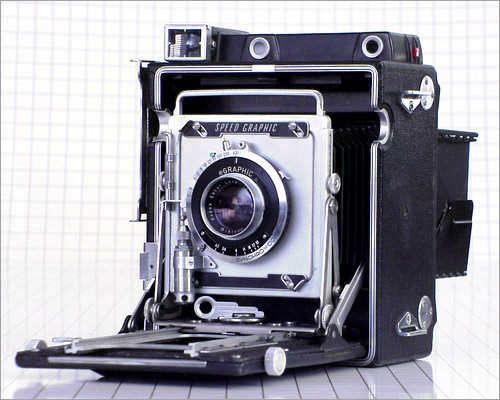
Graflex Pacemaker Speed Graphic
1955
sheet film, Polaroid or 120 roll film
4" x 5" image size (6cm x 12cm with 120 film)
1 exposure per sheet (8 exposures per roll)
127mm f/4.7 Kodak Ektar (coated)
Synchro-Compur (T, B - 1/400th, MX sync)
top-mounted Graflex coupled rangefinder
ground glass back (view back)
solenoid (electronic) shutter release
|
|
|
|
|
The Graflex Pacemaker Speed Graphic is an incredible camera. It's a folding box camera that was designed (like other medium format systems) to be extremely versatile. The lenses can be changed (to virtually any lens made), the backs can be changed (4" x 5", 6cm x 9cm, 6cm x 12cm, Polaroid, etc), and it has two shutters - a focal plane shutter that's built into the camera body and a separate shutter that's built into the lens.
The shutter that's built into the lens can be triggered electronically by applying a small voltage to a solenoid that's attached to it. The focal plane shutter is a curtain shutter and operates at speeds up to 1/1000th of a second. The way it achieves such high speeds, even though the film size (and thus the shutter size) is four inches by five inches (10cm x 13cm), is by means of a curtain with a slit in it that scans across the film plane.
The Pacemaker Speed Graphic has three ways of previewing the image. One is through the lens (by attaching the ground glass back), another is by using the rangefinder that's on top of the camera, and another is by using the wire frame "sports finder" which pops up above the camera.
The lens on this camera can shift, tilt and rise for perspective correction. The rangefinder is coupled to the lens (actually to the geared rails that move the lens forward and back). And for working in very low light the rangefinder has an internal light source and can project two points of light onto the subject. By using the rangefinder's optics in reverse this allows you to change the focus manually until the two points merge into one - and when they do it's in focus. |
|
|